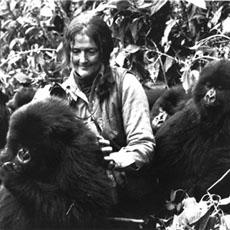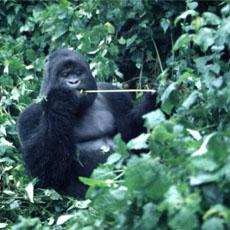
STEVE EMBER: I'm Steve Ember.
FAITH LAPIDUS: And I'm Faith Lapidus with PEOPLE IN AMERICA in VOA Special English. Today we tell about Dian Fossey. She studied the wild mountain gorillas of central Africa. Her work resulted in efforts to save these rare and endangered animals.
(MUSIC)
STEVE EMBER: Dian Fossey was born in 1932 in San Francisco, California. Her parents ended their marriage when she was young. She stayed with her mother, who married another man a short time later. Dian said she had a difficult relationship with both her mother and stepfather.
Dian was interested in animals all her life. She started making plans to be a veterinarian, a doctor who treats animals. After high school, she attended San Jose State College in California. There, she was successful in some subjects, but not others.

She changed her program of study to occupational therapy. Occupational therapists help injured and sick people learn to do their day-to-day activities independently. She completed her studies at San Jose State in 1954.
FAITH LAPIDUS: Dian Fossey left California and moved to the state of Kentucky. She accepted a position at the Kosair Crippled Children's Hospital in the city of Louisville. People there said she had a special gift of communicating with children with special needs. Yet she also had a desire to see more of the world.
Through friends, she became interested in Africa. She read a book about the wild mountain gorillas of central Africa written by American zoologist George Schaller. The mountain gorilla is the largest of the world's apes.
STEVE EMBER: Fossey borrowed money and made a six-week trip to Africa in 1963. She visited a camp operated by the famous research scientists Louis and Mary Leakey. The Leakeys were best known for their studies of the development of human ancestors.
Fossey met with Louis Leakey and discussed the importance of scientific research on the great apes. She decided to study mountain gorillas, which were in danger of disappearing. Later on her trip, she traveled to the mountains of Rwanda. This is where she first saw mountain gorillas.
FAITH LAPIDUS: Fossey returned to the United States with a desire to work in Africa. She met with Professor Leakey a second time when he visited the United States to give a series of talks. This time, he asked her to begin a long-term study of the gorillas. He said information she collected might help to show how human ancestors developed.
A group called the Wilkie Foundation agreed to support her research. The Wilkie Foundation already supported another researcher, Jane Goodall, in her study of wild chimpanzees. Fossey also received help from a major scientific and educational organization -- the National Geographic Society.
STEVE EMBER: Fossey returned to central Africa in 1966. She spent a short time observing Jane Goodall. Then she began setting up her own research camp in what was then the country of Zaire. Fossey sought help from the local native people who knew how to follow mountain gorillas in the wild.
A short time later, political unrest forced her to move to nearby Rwanda. She settled in a protected area between two mountains, Karisimbi and Visoke. There, she established the Karisoke Research Center. This would be her home for most of the next 18 years. Much of that time, she worked alone.
(MUSIC)

FAITH LAPIDUS: Dian Fossey spent thousands of hours observing mountain gorillas. She worked hard to gain acceptance among the animals. To do this, she copied their actions and sounds. She studied the gorillas daily and developed an understanding of each individual.
Many people had believed that mountain gorillas are fierce. Fossey found just the opposite. She learned that gorillas are both gentle and intelligent. They use their strength mainly when defending other members of their family or group.
STEVE EMBER: In 1970, the National Geographic Society wanted to publish a story about Fossey and her research. It sent a photographer named Bob Campbell to Karisoke to take pictures. He took a picture of an adult male gorilla named Peanuts touching Fossey's hand. This became the first friendly gorilla-to-human action ever recorded. The picture appeared on the front cover of National Geographic magazine. It helped to make Fossey and her work famous.
The American researcher was able to sit among the gorillas and play with them and their young. She made notes of everything she saw. She took a count, or census, of the gorilla population. She noted what the animals ate and their environment.
Fossey learned a lot about the gorillas. But it became difficult for her to remain an independent observer. She believed that the animals would disappear forever unless something was done to protect them and their environment.
(MUSIC)
FAITH LAPIDUS: Dian Fossey needed money to continue her research project. She believed that she could get more financial assistance for her work by getting an advanced degree. She left Africa in 1970 and attended the University of Cambridge in England. She received a doctorate in zoology a few years later.
Fossey returned to Rwanda to find that hunters were killing some of what she called "her gorillas." The hunters earned money by selling the heads, hands and feet of the animals. Among the gorillas killed was one called Digit.
Fossey had observed Digit for many years and treated him almost like a friend. His remains were placed with those of other dead gorillas in a special burial area near her camp.
STEVE EMBER: After Digit was killed, Fossey established a program to increase international support for efforts to protect mountain gorillas. It was called the Digit Fund. Fossey also began an active campaign to stop the killing of the gorillas. She opposed efforts by Rwandan officials to increase the number of visitors to the animals' native environment.
She formed a small force to help guard mountain gorillas against humans. She destroyed traps used to catch the animals. She threatened the hunters and the people who helped them. National Geographic magazine published a report about her efforts. Many people who read the story sent money to support the campaign.
However, not everyone supported what Fossey was doing. Some people condemned her treatment of the hunters. Rwandan officials opposed her efforts to control an area that she did not own. And, some animal experts criticized her strong emotional links with the gorillas. They also questioned her work as a scientist.
(MUSIC)
FAITH LAPIDUS: Dian Fossey suffered from a number of health problems. As she grew older, she spent less time in the field and more time at her camp doing paperwork. This was partly because she had college students assisting in her research efforts.
In 1980, Fossey left Karisoke and accepted a position at Cornell University in Ithaca, New York. There, she began to write a book about her years with the mountain gorillas. Her book was published in 1983. It is called "Gorillas in the Mist." By then, there were only about 200 mountain gorillas in the world.
Dian Fossey made a large number of public appearances to publicize her book and the efforts to save the mountain gorillas. Then she returned to Rwanda. On December 26th, 1985, she was found murdered at her camp. A few days later, her body was buried near the remains of some of her gorillas.
STEVE EMBER: Even now, her death remains unsolved. Some people believe that she was killed by someone who opposed her strong attempts to protect the gorillas.
Three years after her death, a major American motion picture based on her book was released. It is also called "Gorillas in the Mist." It helped tell her story to millions of people around the world.
Dian Fossey kept a written record of her daily activities. She wrote: When you understand the value of all life, you think less about what is past and think instead about the protection of the future.
Dian Fossey loved her work and used her research to help save the gorillas and their environment. Today, the mountain gorilla population is increasing. Some people have said that without her efforts the animals would no longer exist. The Dian Fossey Gorilla Fund International continues her work.
(MUSIC)
FAITH LAPIDUS: This program was written by George Grow. Lawan Davis was our producer. I'm Faith Lapidus.
STEVE EMBER: And I'm Steve Ember. Join us again next week for PEOPLE IN AMERICA in VOA Special English.
Martin Luther King Jr. memorial nearing completion in Washington
People in America - Bob Feller, 1918-2010: One of baseball's finest pitchers
Patsy Cline, 1932-1963: fans were 'crazy' about this young country music star
Flannery O'Connor, 1925-1964: she told stories about people living in the American South
(来源:VOA 编辑:崔旭燕)
